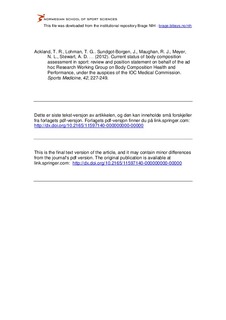| dc.contributor.author | Ackland, Timothy R. | |
| dc.contributor.author | Lohman, Timothy G. | |
| dc.contributor.author | Sundgot-Borgen, Jorunn | |
| dc.contributor.author | Maughan, Ronald J. | |
| dc.contributor.author | Meyer, Nanna L. | |
| dc.contributor.author | Stewart, Arthur D. | |
| dc.contributor.author | Muller, Wolfram | |
| dc.date.accessioned | 2013-04-11T08:12:55Z | |
| dc.date.available | 2013-04-11T08:12:55Z | |
| dc.date.issued | 2012 | |
| dc.identifier | Seksjon for idrettsmedisinske fag / Department of Sports Medicine | |
| dc.identifier.citation | Sports Medicine. 2012, 42, 227-249 | no_NO |
| dc.identifier.issn | 1179-2035 | |
| dc.identifier.uri | http://hdl.handle.net/11250/171130 | |
| dc.description | I Brage finner du siste tekst-versjon av artikkelen, og den kan inneholde ubetydelige forskjeller fra forlagets pdf-versjon. Forlagets pdf-versjon finner du på link.springer.com: http://dx.doi.org/10.2165/11597140-000000000-00000 / In Brage you'll find the final text version of the article, and it may contain insignificant differences from the journal's pdf version. The definitive version is available at link.springer.com: http://dx.doi.org/10.2165/11597140-000000000-00000 | no_NO |
| dc.description.abstract | Quantifying human body composition has played an important role in monitoring all athlete performance and training regimens, but especially so in gravitational, weight class and aesthetic sports wherein the tissue composition of the body profoundly affects performance or adjudication. Over the past century, a myriad of techniques and equations have been proposed, but all have some inherent problems, whether in measurement methodology or in the assumptions they make. To date, there is no universally applicable criterion or `gold standard' methodology for body composition assessment. Having considered issues of accuracy, repeatability and utility, the multicomponent model might be employed as a performance or selection criterion, provided the selected model accounts for variability in the density of fat-free mass in its computation. However, when profiling change in interventions, single methods whose raw data are surrogates for body composition (with the notable exception of the body mass index) remain useful. | no_NO |
| dc.language.iso | eng | no_NO |
| dc.publisher | Adis Data Information | no_NO |
| dc.subject | body composition | no_NO |
| dc.subject | anthropometry | no_NO |
| dc.subject | adipose tissues | no_NO |
| dc.subject | athletes | no_NO |
| dc.subject | energy metabolism | no_NO |
| dc.subject | bioelectric impedance | no_NO |
| dc.subject | magnetic resonance imaging | no_NO |
| dc.subject | plethysmography | no_NO |
| dc.subject | skinfold thickness | no_NO |
| dc.subject | tomography | no_NO |
| dc.subject | ultrasonic imaging | no_NO |
| dc.subject | urine analysis | no_NO |
| dc.subject | body mass index | no_NO |
| dc.subject | lean body mass | no_NO |
| dc.subject | hydrostatic weighing | no_NO |
| dc.subject | x-ray densitometry | no_NO |
| dc.title | Current status of body composition assessment in sport: review and position statement on behalf of the ad hoc Research Working Group on Body Composition Health and Performance, under the auspices of the IOC Medical Commission | no_NO |
| dc.type | Journal article | no_NO |
| dc.type | Peer reviewed | no_NO |
| dc.subject.nsi | VDP::Social science: 200::Social science in sports: 330 | no_NO |
| dc.source.journal | Sports Medicine | |
| dc.identifier.doi | 10.2165/11597140-000000000-00000 | |
